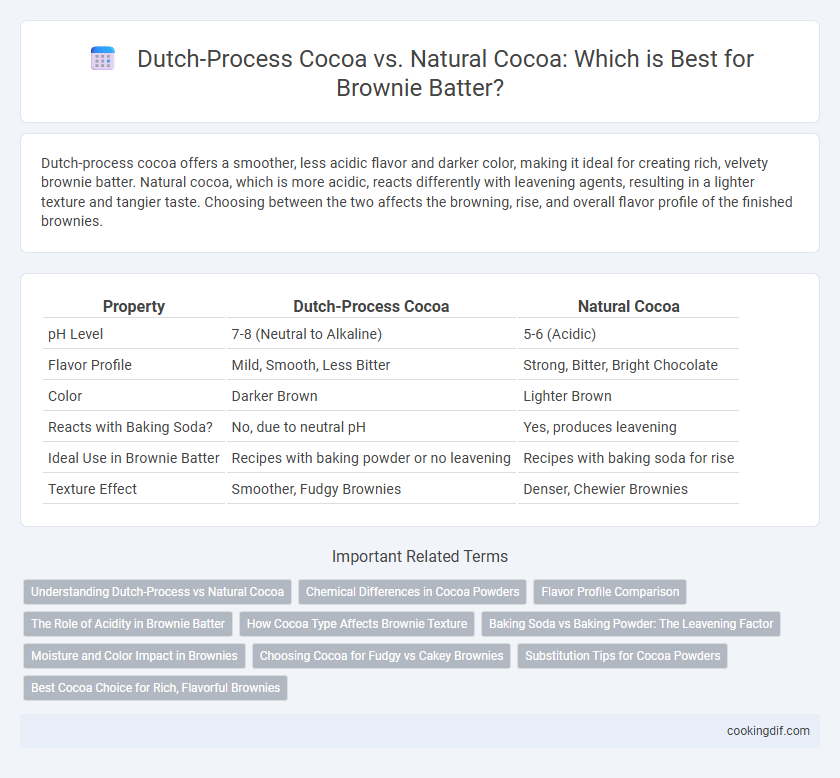Dutch-process cocoa offers a smoother, less acidic flavor and darker color, making it ideal for creating rich, velvety brownie batter. Natural cocoa, which is more acidic, reacts differently with leavening agents, resulting in a lighter texture and tangier taste. Choosing between the two affects the browning, rise, and overall flavor profile of the finished brownies.
Table of Comparison
| Property | Dutch-Process Cocoa | Natural Cocoa |
|---|---|---|
| pH Level | 7-8 (Neutral to Alkaline) | 5-6 (Acidic) |
| Flavor Profile | Mild, Smooth, Less Bitter | Strong, Bitter, Bright Chocolate |
| Color | Darker Brown | Lighter Brown |
| Reacts with Baking Soda? | No, due to neutral pH | Yes, produces leavening |
| Ideal Use in Brownie Batter | Recipes with baking powder or no leavening | Recipes with baking soda for rise |
| Texture Effect | Smoother, Fudgy Brownies | Denser, Chewier Brownies |
Understanding Dutch-Process vs Natural Cocoa
Dutch-process cocoa undergoes alkaline treatment that neutralizes its acidity, resulting in a smoother, milder flavor and darker color ideal for rich brownie batters. Natural cocoa retains its acidity, offering a sharper, more robust chocolate flavor and better leavening reaction with baking soda in recipes. Choosing between Dutch-process and natural cocoa depends on the desired taste intensity and chemical interactions for optimal brownie texture.
Chemical Differences in Cocoa Powders
Dutch-process cocoa undergoes alkalization, which neutralizes its natural acidity and results in a darker color and smoother flavor, while natural cocoa retains its acidic properties with a more robust, slightly bitter taste. The pH level of Dutch-process cocoa ranges from 7 to 8, compared to natural cocoa's pH of around 5 to 6, impacting how it reacts with leavening agents like baking soda or baking powder in brownie batter. This chemical difference affects both the texture and rise of brownies, making it essential to choose cocoa types based on the recipe's leavening system.
Flavor Profile Comparison
Dutch-process cocoa offers a smoother, less acidic flavor with deep chocolate notes, enhancing the richness of brownie batter. Natural cocoa provides a more intense, sharp chocolate taste with fruity and smoky undertones, contributing to a tangier flavor profile. Choosing between the two impacts the final taste, with Dutch-process yielding mellow complexity and natural cocoa delivering bold, robust chocolate character.
The Role of Acidity in Brownie Batter
Dutch-process cocoa has a neutral pH, which reduces acidity in brownie batter and results in a smoother, less tangy flavor with a darker color. Natural cocoa is acidic, causing the batter to react with baking soda, creating carbon dioxide that helps brownies rise and develop a lighter crumb. The acidity in natural cocoa also enhances the chocolate's brightness, contributing to a more complex taste profile compared to Dutch-process cocoa.
How Cocoa Type Affects Brownie Texture
Dutch-process cocoa produces a smoother, richer brownie texture due to its alkalized properties, which neutralize acidity and promote even browning. Natural cocoa, being more acidic, reacts with baking soda to create a lighter, cakier texture with a sharper chocolate flavor. Choosing Dutch-process cocoa results in fudgier brownies, while natural cocoa yields a tender crumb and slightly tangy taste.
Baking Soda vs Baking Powder: The Leavening Factor
Dutch-process cocoa is alkalized, neutralizing its acidity, which means it pairs well with baking powder that requires a neutral pH to activate. Natural cocoa is acidic and reacts with baking soda to produce carbon dioxide, creating leavening and resulting in a lighter brownie texture. Using the correct leavening agent ensures proper rise and optimal flavor development in brownie batter.
Moisture and Color Impact in Brownies
Dutch-process cocoa is alkalized to neutralize its acidity, resulting in a darker color and smoother, less acidic flavor in brownie batter. This processing also affects moisture retention by producing a slightly thicker batter that holds moisture better, leading to fudgier brownies. Natural cocoa, being more acidic and lighter in color, interacts differently with leavening agents, which can yield a lighter, cake-like texture with less moisture retention.
Choosing Cocoa for Fudgy vs Cakey Brownies
Dutch-process cocoa, treated with an alkalizing agent, offers a smoother, milder flavor and darker color, making it ideal for fudgy brownies with rich, intense chocolate notes. Natural cocoa, with its acidic profile, reacts with baking soda to create a lighter, cakey texture and tangy taste, perfect for brownies that are airy and soft. Selecting Dutch-process cocoa emphasizes moisture and depth, while natural cocoa enhances rise and crumb structure in your brownie batter.
Substitution Tips for Cocoa Powders
Dutch-process cocoa offers a mellow, less acidic flavor and darker color compared to natural cocoa, making it ideal for recipes with baking powder rather than baking soda. When substituting Dutch-process for natural cocoa in brownie batter, adjust leavening agents accordingly to prevent texture changes and maintain desired rise. To preserve the deep chocolate flavor and fudgy texture, reduce baking soda or replace it with baking powder when using Dutch-process cocoa.
Best Cocoa Choice for Rich, Flavorful Brownies
Dutch-process cocoa offers a smoother, less acidic flavor with deep chocolate notes, making it the best cocoa choice for rich, flavorful brownies. Its alkalized properties enhance cocoa's natural sweetness, resulting in a velvety texture and intensified chocolate taste in the batter. Natural cocoa, being more acidic, reacts with baking soda to leaven brownies but can yield a sharper, more bitter flavor compared to the mellow depth of Dutch-process cocoa.
Dutch-process cocoa vs natural cocoa for batter Infographic

 cookingdif.com
cookingdif.com